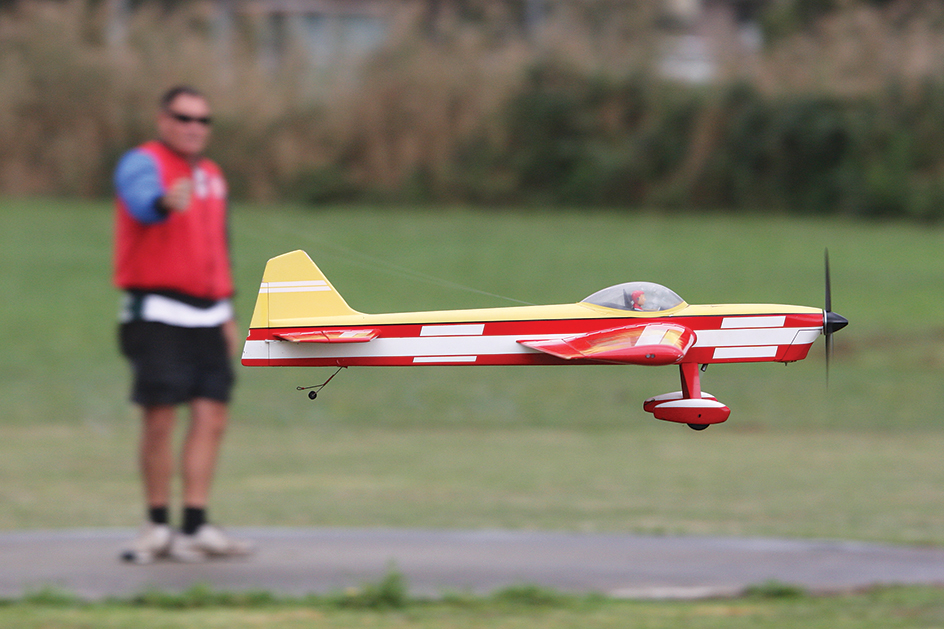Airplane, Model, is a miniature airplane. It may be a copy of a full-sized plane or have an original design. Building model airplanes is a popular hobby. There are flying and nonflying miniature aircraft of all types, including gliders and helicopters. Scale models can be of commercial and military planes. Scientists also use scale models of aircraft for testing before full-sized planes are built. They test the models in wind tunnels, where the airflow around the model is carefully controlled. See Airplane (Design and testing) ; Wind tunnel .
Models may be powered by twisted rubber bands, electric motors, gas or diesel engines, or compressed carbon dioxide. Most model planes take off under their own power, but some are hand-launched.
In the United States, the organization that regulates official model airplane contests is the Academy of Model Aeronautics (AMA). In Canada, it is the Model Aeronautics Association of Canada (MAAC). These groups certify flying records and sponsor contests in skills such as scale detail and accuracy of flight maneuvers.
Hobbyists generally build model airplanes from kits sold by hobby stores. Most kits of nonflying models consist of plastic parts that the modeler glues together. Balsa wood and foam rank as the most popular materials for flying models because they are light, strong, and easy to work with. Various kinds of synthetic materials may be used for parts of a model that require extra strength, such as the landing gear and engine mount. Hobbyists also build models from plans published in magazines. Advanced modelers sometimes design their own planes. Many planes are purchased assembled and ready to fly.
There are five main kinds of model airplanes. They are (1) display, (2) indoor, (3) free-flight, (4) control-line, and (5) radio control.
Display models
cannot fly. Hobbyists build them with the goal of duplicating the appearance of full-sized aircraft in every possible detail. Some display models have movable propellers, doors, and landing gear. Hobbyists take care in painting these models to make them look authentic. The models are judged at exhibitions on the basis of workmanship and accuracy of detail. Display models make attractive decorations in a home. Some modelers display their planes by hanging them from the ceiling by wires or exhibiting them in display cases.
Indoor models
are flown only inside a building. They fly slowly, and some can stay aloft as long as 45 minutes. An indoor model is powered by twisted strands of rubber that turn the propeller as they unwind. These airplanes have a balsa frame covered by thin paper or a substance called microfilm. Microfilm is made by mixing lacquer and castor oil and floating the mixture on water to form a clear, thin film. The modeler removes the film with a wire loop and applies it to the plane’s frame. Such models weigh 1/30 ounce (1 gram) or less. They are too fragile to be flown outdoors, where they might collapse at the slightest movement of air. Indoor gliders are typically made entirely of balsa.
Free-flight models
may be powered by rubber strands or have a piston engine. Engine-powered free-flight models run on a mixture of methyl alcohol, nitromethane, and a lubricant. Diesel engines, using a mixture of kerosene, ether, and castor oil, are also used, and so are electric motors with rechargeable batteries. Such models built for competitive flying typically have wings from 3 to 6 feet (0.9 to 1.8 meters) long. After launching, a free-flight model climbs straight up for 5 to 15 seconds. A timing device then turns the engine off, and the plane goes into a slow glide for 3 to 5 minutes. Some engine-powered free-flight models that do not have a timing device can fly in a circular pattern for hours. Flying in rising air currents called thermals helps them remain airborne.

A free-flight glider may be hand-launched or it may be towed at the end of a cord and then released. Such gliders have remained airborne for many hours by flying in thermals.
Control-line models
have piston or jet engines and fly at the end of wires. Most control-line models have two Dacron or steel wires that measure from 25 to 75 feet (8 to 23 meters) long. One end of each wire is attached to the model and moves the plane’s elevator, a control surface on the tail assembly. The other end is fastened to a handle that the modeler uses to control the plane’s altitude and flight path. When the hobbyist tilts the handle up, one wire raises the elevator, pointing the nose of the plane upward. Tilting the handle down causes the other wire to lower the elevator and point the plane’s nose downward.

Some control-line models have only one line, which both raises and lowers the elevator. Others have a third line that controls the engine power and thus the speed of the plane. Jet-powered control-line models have flown nearly 250 miles (400 kilometers) per hour.
Radio control models
are controlled by means of a transmitter that sends radio signals to the airplane. The model carries a tiny radio receiver that decodes the signals and passes the information to electric motor devices called servos. The servos move control surfaces on the wings and tail assembly, enabling the model to rise, sink, or turn. Servos can also control the speed of the plane’s engine and even lift and lower the landing gear. Some radio control models are slow enough to be flown indoors. Radio control is also used to pilot model helicopters and racing and acrobatic model aircraft.

Some radio control gliders rank among the largest model airplanes. Their wings measure from 9 to 16 feet (3 to 4.9 meters) long. These long wings enable the plane to stay aloft for extended periods when steered into thermals.
